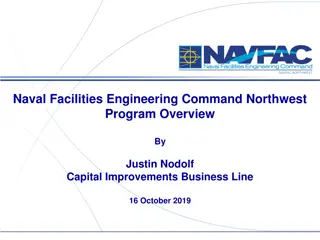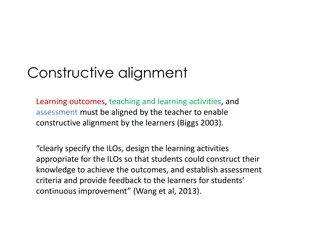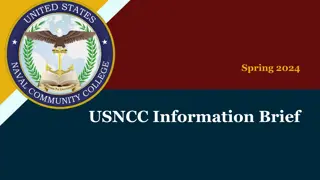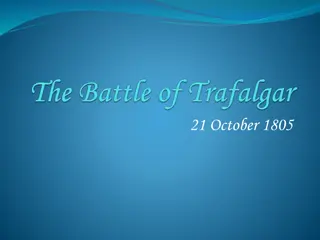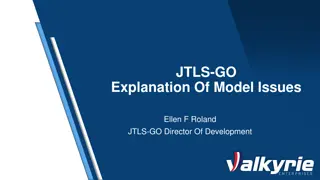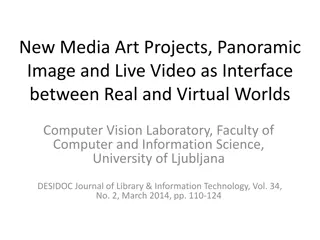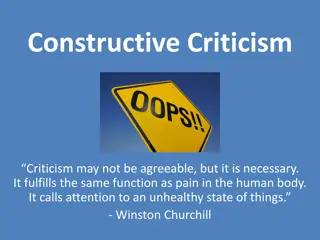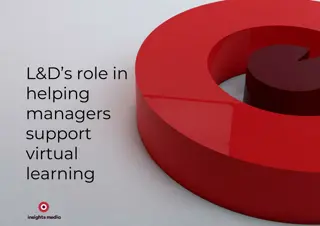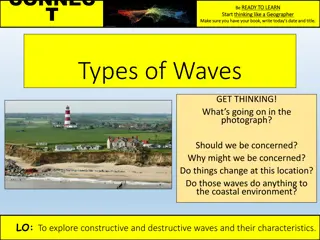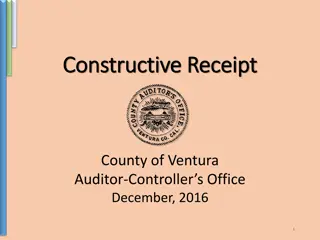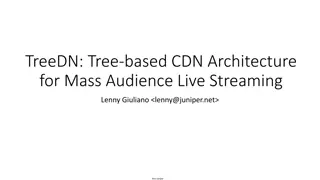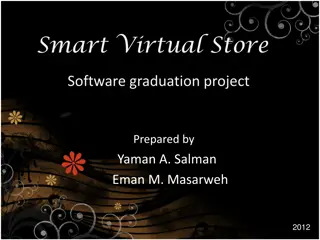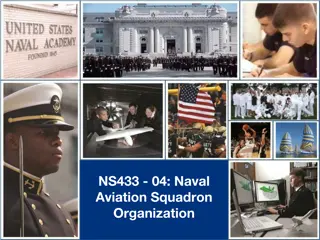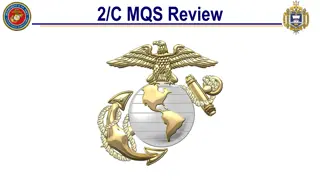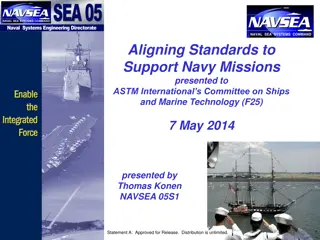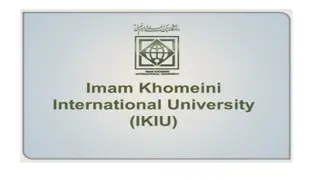Naval Live, Virtual, Constructive Learning Laboratory Overview
The Naval Live, Virtual, Constructive (LVC) Learning Laboratory, led by Mr. Christian Fitzpatrick, aims to provide a platform for early-stage research and development in a synthetic environment. With a strategic vision to build the future force, the lab focuses on integrated research, test, and evaluation to support emerging naval concepts. The purpose is to serve as a crossroads for the Navy, Marine Corps, academia, and industry, initially emphasizing Project TRIPOLI. Research thrust areas cover operational content, architecture, interoperability, performance assessment, training effectiveness, and more.
Download Presentation

Please find below an Image/Link to download the presentation.
The content on the website is provided AS IS for your information and personal use only. It may not be sold, licensed, or shared on other websites without obtaining consent from the author. Download presentation by click this link. If you encounter any issues during the download, it is possible that the publisher has removed the file from their server.
E N D
Presentation Transcript
Live Virtual Constructive Learning Laboratory Mr. Christian Fitzpatrick 23 May 2023 Email: christian.fitzpatrick@nps.edu Phone: (831) 656-6992
Agenda Strategic Vision Purpose of the LVC Learning Laboratory Research Thrust Areas Network Connectivity Organization LVC Workshop Current Lines of Effort Supporting the Vision
Strategic Vision The strategic vision for the Naval Live, Virtual, Constructive (LVC) Learning Laboratory (LVCLL) is to provide the entire Naval Research Enterprise (NRE) a persistent forum to conduct early-stage research, development, test, and evaluation (RDT&E) of emerging naval concepts in a readily available integrated synthetic environment (ISE) On and off campus, the LVCLL will become a distributed laboratory, classroom, and think tank where Sailors, Marines, Navy scientists, and industry partners can work together to build the future force We are starting this process with MV4504 in the Winter
Purpose of the LVC Learning Laboratory The purpose of the Naval LVCLL is to create a research, development, experimentation, and education crossroads for the Navy, Marine Corps, academia, and industry Our focus will initially be on Project TRIPOLI, the Marine Corps Training and Education Command s (TECOM) LVC-Training Environment (LVC-TE) development effort We will be investigating the utility of Tactical Cloud Architectures and 5G Communications networks to support distributed LVC events during MV4504 Since it is a comprehensive M&S program that integrates all the major concerns of future large-scale enterprise M&S, it helps us identify our initial thrust areas that are universal across the armed services and industry within the DoD industrial base
Research Thrust Areas Thrust Area II Thrust Area II Operational and Operational and Environmental Content Environmental Content Thrust Area I Thrust Area I Architecture and Architecture and Interoperability Interoperability Thrust Area III Thrust Area III Performance Assessment Performance Assessment Training Effectiveness VV&A Exercise Design Wargaming Automated AAR Analytics Individual/Collective Feedback Field Experimentation Searchable Experiential Archives Performance Assessment Tools Human Behavior Simulation Whole Earth Multiscale Database Integration of Real World Data Composable Model Aggregation Constructive Simulation Live Sensing and Integration Virtual Simulation AR/VR Autonomous Entities Scenario Authoring Cyber, EW, and Logistics Domains Open, modular, microservices architecture Distributed Interoperability C2 System Integration Portability/Deployability CLASSIFIED/UNCLASSIFIED Compatibility Reconstruction/Playback Government/Industry Collaboration
Network Connectivity NPS will be on the SDREN in Dec 2023 First test will be with the Integrated Battlespace Arena (IBAR) at China Lake I MEF is expecting connectivity at the end of FY23 This connection will allow MOVES to participate in future NILEX events
LVC Learning Laboratory The LVCLL will enhance collaboration by conducting sponsored research within three research thrusts: Architecture and Interoperability, Operational and Environmental Content, and Performance Assessment Sponsored research will be enabled through the execution of five (5) joint projects between NPS and industry, 5 projects between NPS and Naval Labs, and two (2) projects between NPS and academia The projects must support one of the research thrusts mentioned above Each will be funded for $200,000 through a $2.4M allocation of funds for the Naval LVCLL from a Fleet sponsor The funds will be distributed based on a review of submitted proposals which will be requested 4 months prior to the beginning of the fiscal year (FY)
LVC Learning Laboratory The MOVES Director will lead the Naval LVCLL and will report significant events, Fleet engagements, and research progress quarterly to the NPS President The Naval LVCLL Advisory Board will support the MOVES Director with project selection, Fleet integration, and sharing RDT&E findings across the services The Advisory Board will be chaired by the Commanding General, TECOM and Deputy Chief of Naval Operations for Warfighting Development, N7 Other representatives include the Navy Modeling and Simulation Office (NMSO), the Marine Corps Modeling and Simulation Management Office (MCMSMO), Office of Naval Research (ONR), Marine Corps Warfighting Lab (MCWL), and the Naval Warfare Studies Institute (NWSI) The Naval LVCLL will publish an annual report providing an overview of funded research executed during the previous FY.
Upcoming LVC Workshop Planned to host LVC community leaders across the Fleet to begin the development of a focused Science and Technology (S&T) Master Plan for the execution of LVC events in the testing, training, and evaluation communities We anticipate this to be an annual event where the LVC community can meet to discuss current projects, on-going research, and actual TT&E events in an effort to update the LVC S&T Master Plan We seek to use this document to guide student thesis and dissertation selection In addition, we will try to align the workshop with end-of-year reporting on the 12 research projects planned for the LVCLL We have been working on building content for the LVC Workshop in MV4460 Management of Modeling & Simulation Development Definition of LVC: A set of integrated, interoperable simulation tools including live, virtual, and/or constructive components to meet joint and coalition testing, training, and evaluation needs, developed to create more collaborative, economical, safer, and secure conduct of events.
FY22-23 Projects ONR Tech Solutions Project #913: Small Unit Mission Planner (Dr. Blais and Major Hickey) NPS-23-N255: Improving Identification of Ship Tracks Using a Data Driven Approach (Dr. Balogh) NPS-23-M197A: Enhancing the USMC VTOL Family of Systems (Mr. Scot Miller) Systems Engineering Capstone: Assessing Pilot Task Saturation in the Future Vertical Lift (FVL) during Expeditionary Advanced Base Operations (EABO) (Dr. Bonnie Johnson) Modeling the Value of Naval Presence (Dr. Jerry Hendrix and Dr. Balogh) CRUSER: Interactive Synthetic Environment (ISE) to Evaluate Zero-Carbon UAS Launch Platforms in the Arctic (Dr. Dew and Dr. Balogh) NMSO: Integrated Naval Testing, Training, and Evaluation Environments (Dr. Balogh)
FY22-23 Projects Operational Energy Capability Improvement Fund (OECIF): Airship Deployment for DoD Missions in a Contested Battlespace (Mr. Chris Fitzpatrick) Operational Energy Capability Improvement Fund (OECIF): Tactical Cloud Architectures and 5G Communications for Distributed Live Virtual Constructive Training Environments (Mr. Chris Fitzpatrick)
Modeling the Value of Naval Presence The US Navy has a long-standing, global mission to defend freedom, preserve economic prosperity, and keep the seas open and free (US Navy, 2022) This is no small task and requires the keen management of both time & space and resources & their allocation Consider a simple metric; there are 134 million square miles of ocean in the world (Roger Williams University, 2022). This will only increase by mid-century when we anticipate the Arctic Ocean to be ice-free and fully trafficable in the summer months adding an additional 5 million square miles to patrol (Kramer, 2021) The Chief of Naval Operations (CNO) must provide naval presence in these areas with a limited sized Fleet of surface ships Status of US Navy Ships Underway as of 15 Dec 2022 Source US Navy, 2022
Interactive Synthetic Environment (ISE) to Evaluate Zero-Carbon UAS Launch Platforms in the Arctic Simulation of Operations from Thule AB 115 possible routes Find the best force mix of Airlander 10s and Scan Eagles to support naval surface presence Simulation of Operations from Eielson AFB 77 possible routes Find the best force mix of Airlander 10s and Scan Eagles to support naval surface presence
Integrated Naval Testing, Training, and Evaluation Environments Filters Radar Specific Messages from the Federation and translates them into WDW or PDW messages for transmission to a Live Range Fleet Training Use Case Assessment Fleet Test & Evaluation Use Case Assessment Lab Creation Proof of Concept Event Joint Simulation BUS and Architecture Management Integration Environment Assessment NASMP to WDW/PDW Plugin All messages RTI-S WDW/PDW to NASMP Plugin Threat System Emulator Simulation modeling Red SAM Radar Site Simulation modeling Blue Air (2 x F-35)
Airship Deployment for DoD Missions in a Contested Battlespace For this work, we will be modeling the Airlander 10 and Airlander 50 in various combat simulations to evaluate their utility in the conduct logistics operations and intelligence, surveillance, and reconnaissance (ISR) missions We will also be supporting Hybrid Air Vehicles (HAV) in developing Virtual Reality (VR) applications showing how logistics operations would be conducted in a contested battlespace
Tactical Cloud Architectures and 5G Communications for Distributed Live Virtual Constructive Training Environments This research is intended to develop key performance parameters (KPPs) for network architectures in degraded environments This work will be done in coordination with MV4504 Design and Implementation of LVC Environments We will leverage the AWS CRADA Funded via ONR Next Step


